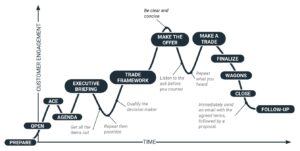Sales used to be all about negotiation. Two people would sit across the table from each other, haggling over the fine points of a proposal until both were confident that they had negotiated the best possible deal.
The problem is the word “negotiation”. It implies that both sides have to give up something that they really want in order to reach an agreement. We talk about negotiation as reaching a win-win outcome, but when both parties feel that they have been forced to compromise, it can feel more like a lose-lose.
There’s a better way to negotiate – one where both salespeople and customers achieve a win-win outcome. The trick is not to negotiate, but to trade.

Figure 1. The progression of a trade.
Using the trade in sales to achieve a win-win
What’s the difference between negotiating and trading? Negotiating pits one side against the other. It’s an adversarial relationship where the goal is to get the other side to give up as much as possible.
Trading is when both parties are on the same side of the table, finding a solution together. An example is offering something you both have in abundance, in exchange for something the other has that you find valuable, being fair for both parties.
Trading has many complex variables. Because there are so many steps to keep in mind, it’s often beneficial to run your thoughts by a colleague, who can help you stay on track and come up with creative solutions from an objective point of view.
How to stop discounting
Traditional negotiations often focus on price. The customer always wants the best price, and they often believe that discounts are a way a seller can demonstrate their commitment.
Discounts can often work in a counterintuitive way. Instead of making your solution seem more valuable, they can make the seller suspicious about your pricing. If you initially offer it at full price and then accept a 20% discount, why didn’t you just offer the 20% discount in the first place?
Even what seems like a small discount can have significant consequences for your company in the long run. In a recurring revenue business model, a 10% discount on a product means that after seven years, your company has brought in only half the revenue that it would have if you had sold it at full price.
The first thing to do is to replace the word “discount” with “price adjustment.” Discount is often expected by the customer just because they asked for it, and they don’t expect to have to give up anything in return for the discount. But if you reframe this as a price adjustment, it now becomes more clear that it’s a part of the trade. So if the customer is requesting a price adjustment, then you would request something in return for that price adjustment. At that point, you can have a collaborative discussion with the customer on what they are interested to trade in return.
The levers to use in a trade
There are multiple levers you can use in a trade. Make it clear from the beginning of the sales conversation that there are several things on the table, and be sure that you’re never framing the discussion as if it’s primarily about price. In fact, make it part of your goal to help the customer realize that they can benefit quite a bit more by focusing less on price and more on the other levers.
Price. As you progress through a trade, a customer may say that your price is too expensive. Careful here; don’t jump to conclusions and assume that you know what that means. They could be referring to the overall cost of the contract, or it could be the amount you’re asking for upfront. Try to unpack where they are coming from. Otherwise, you may offer a price adjustment too soon.
Contract. The length of the contract should always be on the table. Is it a month-to-month agreement, or is the customer committing to a one- or two-year contract?
Payment. The payment schedule is equally important. Will they pay on a Net 30, Net 45, or Net 60 basis? Will there be an annual upfront payment, versus monthly or quarterly payments?
The levers above are the ones that are most often used in trading, but there are many others that should not be overlooked. These include things like case studies (can they commit to a written case study, or perhaps a personal testimonial or quote from their CEO), written reviews on review websites, or workshops with other parts of their organization for expansion purposes? All of these can greatly add to your ability to expand your sales to that same account, or to others in the future.
Remember that an experienced buyer is going to want to negotiate each of these levers separately. For example, they may want to hammer out a price before they move onto contract and payment. This limits your ability to trade. Keep everything on the table until you have come to an agreement.
How to prepare for the Trade meeting
Before the meeting, review your overall strategy and align with any internal colleagues who will join. Make a list of all the trade items that you expect them to bring up. Research who will be attending the meeting on the customer’s end. If there are several people you have not met, consider a ‘call-before-the-call’ with your champion to learn about their concerns.
At the start of the meeting, introduce all the participants. If you are speaking to anyone for the first time, make sure you share some background about “how we got here” before jumping directly into the proposal. Frame the conversation by explaining the different elements of the offer, and be sure to emphasize that it’s a win-win scenario.
The key steps in a trade
Here are the key steps to run through in a well executed trading discussion:
Make a proposal. Summarize your proposal succinctly, making sure to include all of the important levers. Verbalize all proposal items, including overall price, payment terms, contract length, and implementation fees.
Ask for questions: Listen to the customer’s questions or concerns, then repeat back what you’ve heard. The key is to not show any emotion, even if they bring up something that is unreasonable or unexpected. Be direct: “Let me make sure I understand you. You said that instead of a one-year contract, you want to go month-to-month.” Don’t make any promises at this point. Simply mirror what they say.
Prioritize the issues. If the customer has more than one concern, ask them to rank them. “Which one of these issues is most important to you?” Find the reason they’re making that request, so you can then solve for what they really care about.
Qualify the decision-maker. Before heading into the next phase, make sure that they can make a decision at the meeting. You don’t want to give them your best possible deal, only to have them come back later with more requests.
Begin the trade. Start with the easiest items first. Remember that the trading conversation is a give and take. Don’t give something away for free. Always get something for an exchange. This type of relationship is going to be critical at this stage of the deal. Be very clear about what you’re offering and what you need in exchange.
Listen to the counteroffer. Repeat back what they are saying to show that you are listening and want to accommodate them. If they bring up more than one issue, ask them to prioritize them. Occasionally, a customer will make an aggressive or unreasonable demand at the last minute. Respond with this very powerful statement: “That changes the deal.”
Ask for the commitment. When you reach an agreement, it’s time for the big question: “Are you ready to move forward together?”
Add an expiration date. Make sure there are consequences. An expiration date without consequences is meaningless. The consequence may be reverting to the original deal or something else you agree to with the customer. Verbalizing the agreement during the meeting is key. End with: “Does that sound fair?”
Confirm with email and contract. Prepare your follow-up email ahead of time, so that you can send it within 30 minutes of the end of the meeting. Summarize what you agreed to, and emphasize the expiration date. Ask if you missed anything.
A great trading conversation is no longer about us versus them, but instead it’s solving the problem and getting everything on the table. When done well, everyone will leave the meeting feeling that it’s the start of a strong, positive working relationship.

